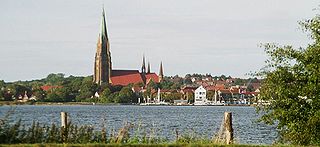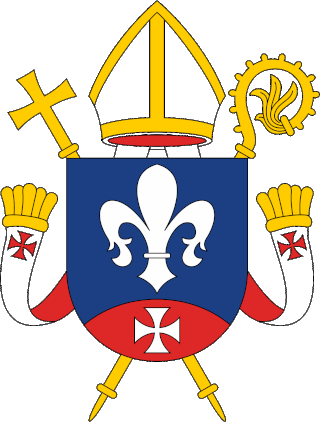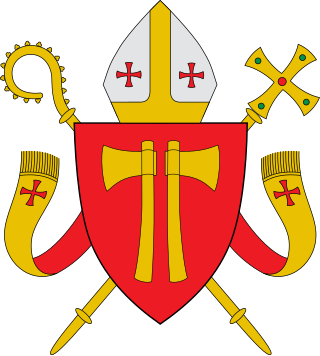
Meissen, is a town of approximately 30,000 about 25 km (16 mi) northwest of Dresden on both banks of the Elbe river in the Free State of Saxony, in eastern Germany. Meissen is the home of Meissen porcelain, the Albrechtsburg castle, the Gothic Meissen Cathedral and the Meissen Frauenkirche. The Große Kreisstadt is the capital of the Meissen district.

The Bishop of Dresden-Meissen is the ordinary of the Roman Catholic Diocese of Dresden-Meissen in the Archdiocese of Berlin.

Upper Lusatia is a historical region in Germany and Poland. Along with Lower Lusatia to the north, it makes up the region of Lusatia, named after the Slavic Lusici tribe. Both parts of Lusatia are home to the West Slavic minority group of the Sorbs.

Dresden Cathedral, or the Cathedral of the Holy Trinity, Dresden, previously the Catholic Church of the Royal Court of Saxony, called in German Katholische Hofkirche and since 1980 also known as Kathedrale Sanctissimae Trinitatis, is the Catholic Cathedral of Dresden.

The Santa Cruz Cathedral Basilica, also known as Kotta Palli or Kottepalli, is located in Fort Kochi, Kochi. It is one of the thirty-four basilicas in India and one of nine in Kerala. This heritage edifice of Kerala is renowned for its Indo-European and Gothic architectural style. It serves as the cathedral church of the Diocese of Cochin.

Regensburg Cathedral, also known as St. Peter's Cathedral, is an example of important Gothic architecture within the German state of Bavaria. It is a landmark for the city of Regensburg, Germany, and the seat of the Catholic Diocese of Regensburg.

Schleswig Cathedral officially the Cathedral of St. Peter at Schleswig, is the main church of the city of Schleswig and was the cathedral of the Bishop of Schleswig until the diocese was dissolved in 1624. It is now a church of the North Elbian Evangelical Lutheran Church, the seat of the Lutheran Bishop of Schleswig and Holstein, and ranks among the most important architectural monuments of Schleswig-Holstein.

The Diocese of Reykjavík is a Latin Church diocese of the Catholic Church which covers the whole of the country of Iceland, and numbered 14,723 Catholics as of 2022. It is directly subject to the Holy See.

The Catholic Church in Iceland is part of the Catholic Church, under the spiritual leadership of the Pope. The island is served by a single diocese, the Diocese of Reykjavík, having a total of seven parishes. As of 2015, the ordinary is bishop Dávid Bartimej Tencer. The diocese is directly subject to the Holy See.

Bremen Cathedral, named after St. Peter, is a church situated in the market square in the center of Bremen. The cathedral belongs to the Bremian Evangelical Church, a member of the umbrella organization Protestant Church in Germany. It is the previous cathedral of the former Prince-Archbishopric of Bremen. Since 1973, it is protected by the monument protection act.
The Vicariate Apostolic of Northern Germany, known for most of its existence as the Vicariate Apostolic of the NorthernMissions, was a Catholic missionary jurisdiction established on 28 April 1667. It belonged to a vicar apostolic in predominantly Protestant Northern Europe.

The Archdiocese of Berlin is a Latin Church ecclesiastical territory or archdiocese of the Catholic Church in Germany. The archepiscopal see is in Berlin, with the archdiocese's territory extending over Northeast Germany.

The Diocese of Dresden–Meissen is a Latin Church diocese of Catholic Church in Germany with its seat in Dresden. It is suffragan to the Archdiocese of Berlin.

Naumburg Cathedral, located in Naumburg, Germany, is the former cathedral of the Bishopric of Naumburg-Zeitz. The church building, most of which dates back to the 13th century, is a renowned landmark of the German late Romanesque and was recognised as a UNESCO World Heritage Site in 2018. The west choir with the famous donor portrait statues of the twelve cathedral founders (Stifterfiguren) and the Lettner, works of the Naumburg Master, is one of the most significant early Gothic monuments.

The Diocese of Görlitz is a Latin Church diocese of the Catholic church in Germany. The current ordinary is Wolfgang Ipolt

The Diocese of Oslo is an exempt Latin Church diocese of the Catholic Church located in the city of Oslo in Norway.

Meissen Cathedral or the Church of St John and St Donatus is a Gothic church in Meissen in Saxony. It is situated on the castle hill of Meissen, adjacent to the Albrechtsburg castle and forms a critical centrepiece of the iconic Meissen skyline overlooking the River Elbe in the valley below.
The Apostolic Vicariate of Saxony was a Latin Church pre-diocesan missionary jurisdiction of the Catholic Church in northern Germany, within the Holy Roman Empire and surviving it, when the Electorate of Saxony became the Kingdom of Saxony.

Johannes Leisentritt, also Johann Leisentrit was a Catholic priest, dean of St. Peter in Bautzen and administrator of the Diocese of Meißen, responsible for Lusatia. He is known for publishing a 1567 hymnal.

















